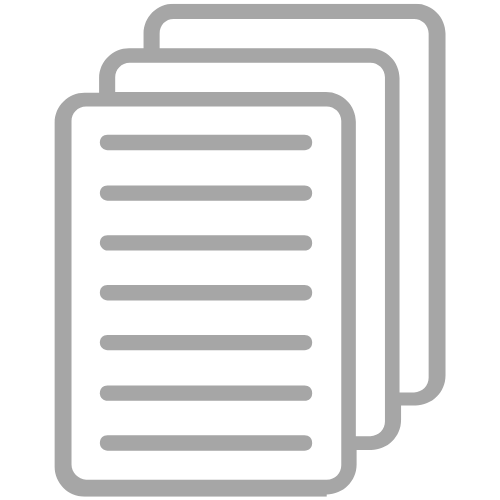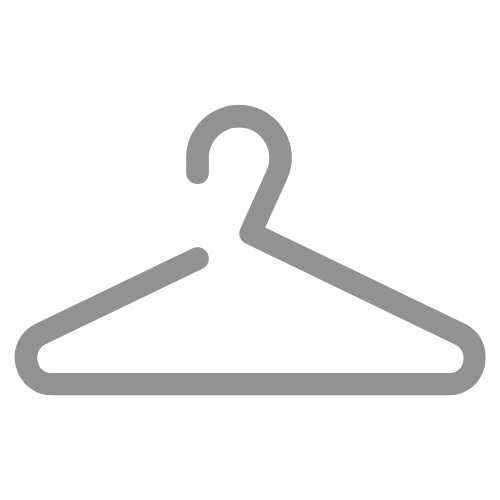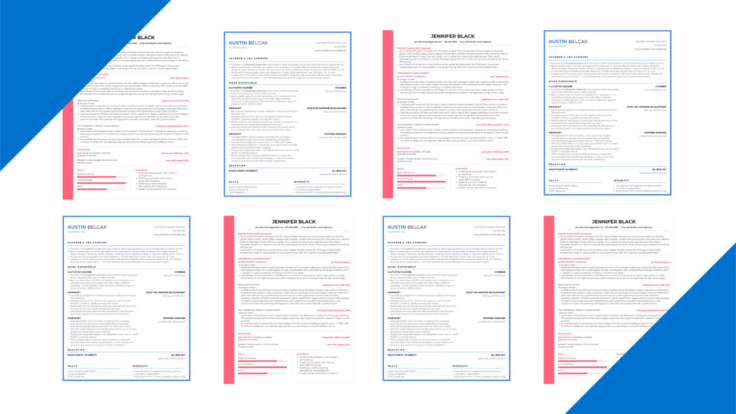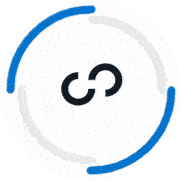“Hi there! This is Jennifer calling from Google. The team absolutely loved you and we'd like to move forward by contacting your resume references. Can you please send them along?”
SCORE! You finally made it, all that work is about to pay off.
You crafted the perfect resume and cover letter. You prepared for and absolutely crushed your interviews. You're SO close you can taste it!
There's only one thing left between you and that sweet, sweet offer — a reference check.
If you're thinking “this is in the bag,” you may want to slow your roll.
While your resume references are usually a formality, choosing the wrong people or presenting them the wrong way can throw up a red flag right as you're about to cross the finish line.
The good news is that if you follow a few simple rules and plan ahead, you'll knock this out of the park and be signing your offer letter in no time.
This post is going to cover everything you need to know about resume references, including:
- Why resume references can make or break your chances of getting a job offer
- Where to put your references (should they even be on your resume?)
- The best way to list and format your references in 2020
- What types of people make great references (and how to ask them)
- 10+ examples of awesome resume reference examples you can steal
You may be asking, who is this guy and why is he qualified to talk about this?
I spent two years making the jump from health care into technology, eventually landing offers at Google, Microsoft, & Twitter. All of those companies asked for my references and I used the exact methods I'm about to share with you to seal the deal with all three.
Now I want to share that info with you so you can replicate those results!
What Are Resume References And Why Are They Important?
A resume reference list is essentially a selection of people who can vouch for your professional skills and confirm that you’re an awesome employee this company should be excited about.
References usually come into play just before the company extends an offer. The team loved you in the interview and they just want to confirm that what you said lines up with other people you've worked with.
When it comes to actually checking, there's a pretty broad range.
Some companies don't bother checking references at all, while some might ask you to provide 5 or more.
You'd rather be fully prepared and burn a few extra minutes for nothing rather than be stuck scrambling to find an ex-colleague with a 24 hour turnaround time!
Should You Put Your References On Your Resume?
Nope! Your references should never show up your actual resume, here's why:
First, resume space is precious.
You just spent hours editing your resume and squeezing it down to a single page. You really don’t want to be wasting valuable space on your carefully edited resume by adding reference details.
On top of that, the company doesn’t need or want your references when you submit your resume. They're still trying to decide if you're even qualified to do the job!
A value driven resume bullet about a project you led is going to be way more effective than giving out your old boss's digits.
Plus, think about where you're submitting your resume. If you're sharing it on LinkedIn, on job boards like Indeed or Angel.co, you're putting up a billboard with people's information for everyone to see!
Your references may have your back now, but that might change if they start getting calls from Nigerian royalty who want to share their fortunes.
“Ok, so should I at least put a line that says ‘References available upon request'?”
Nope! It’s fully expected that you’ll provide references if the company requests them. Again, focus on selling yourself and your experience on your resume. We'll take care of your references in a new doc called your Reference Sheet.
You're going to want to fire up a new Google Doc for your references, but the key here is to make sure you're staying consistent with your resume.
This means that you want to keep the same color scheme, structure, font, and general format on both documents:
 You're on the edge of an offer, so don't drop the ball here with some low effort Times New Roman doc. This is where you highlight your attention to detail and stay consistent with your brand of being awesome!
You're on the edge of an offer, so don't drop the ball here with some low effort Times New Roman doc. This is where you highlight your attention to detail and stay consistent with your brand of being awesome!
You want to make sure that your reference sheet includes:
- Your full name
- Email address
- Phone number
- Link to your LinkedIn profile
You never know who this is going to be passed around to, so you want to make it easy for recruiters and hiring managers to know what candidate these references belong to.
Remember, your goal is to stand out — and paying attention to details on your reference sheet is a surefire way to make that happen.
How To List Your References On A Resume
Should be easy, right? We're just adding some names and contact info here…right?
Not so fast.
If you want to win more job offers, you need to capitalize on every opportunity to add value and control the process.
This means paying attention to detail and creating those opportunities through every step of the process. Listing your references is no different.
How To List And Format Your Resume References
Sure, we're going to drop in some contact information, but we're also going to leverage a tactic to help steer the conversation towards a specific project or result that we want the employer to know and your reference to talk about.
You want to make sure your reference format includes (in order):
- Full Name
- Job Title
- Company/Organization
- Phone Number
- Email Address
- Relationship + Relevant Context
It should look a little something like this:
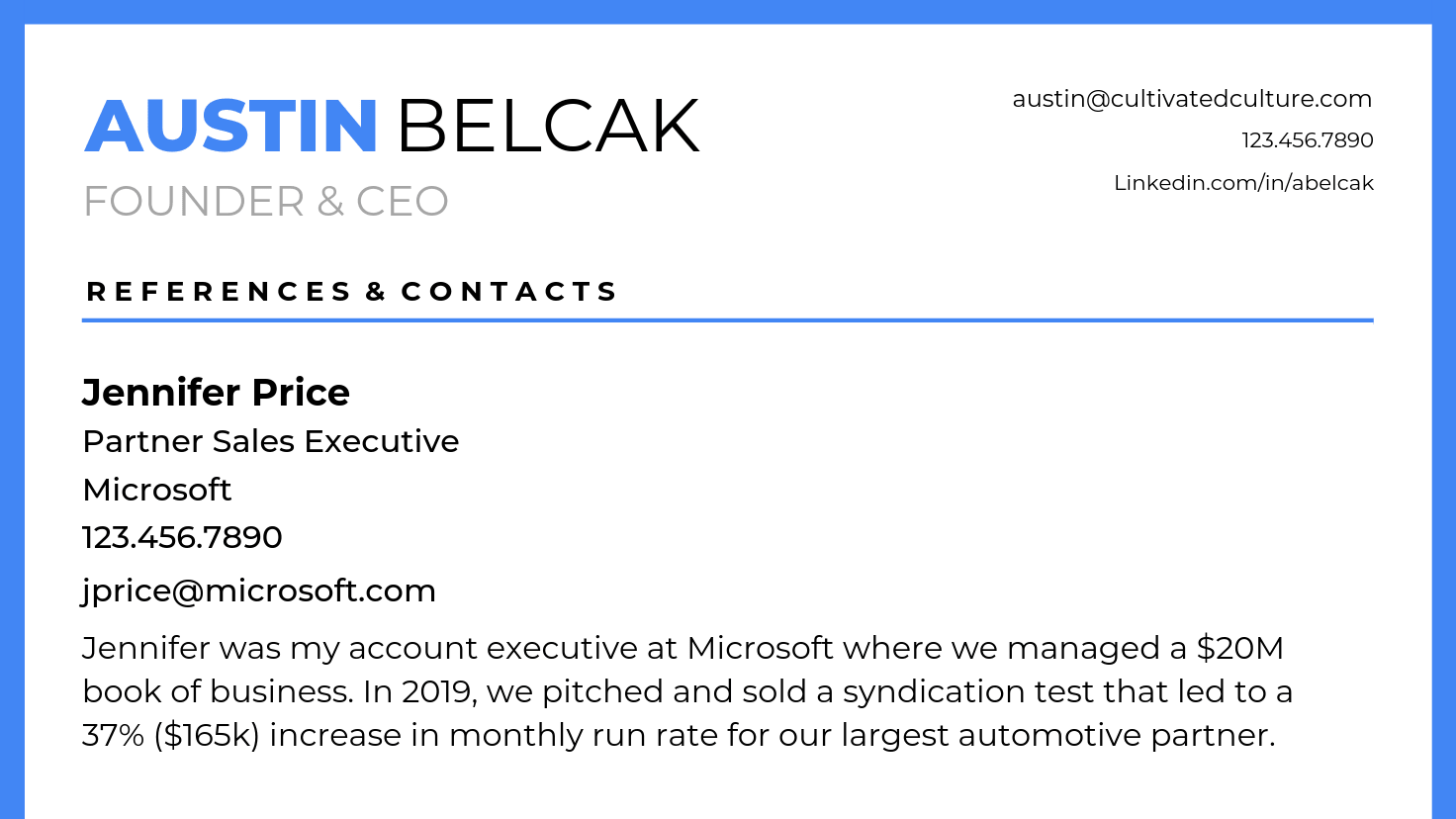
Now, you probably knew about the contact info stuff, but most job seekers miss out on the relevant context piece.
When listing your references, you want to provide a specific detail about a project/initiative you worked on and the results it drove.
Results = value, and value is what gets you hired.
This starts when you reach out to a potential reference. I have instructions and an email template you can use to ask people to be your reference below. When they agree, hop on the phone with them and walk through the game plan:
“Hey Jennifer, thank you so much for offering to be a reference. I really appreciate it! This is for an operations role and the company is focused on increasing productivity/efficiency. It would be great if you could talk them through the Axion project we worked on together where we reduced redundancies by 37% in 6 months!”
Guess what happens next? Your reference starts singing your praises and discussing how amazing that Axion project was and what a great job you did to drive those results.
That’s way better than a typical response like this:
“Uhh yea, I worked with Austin for a couple of years. We were on the same team, he's a nice guy and seems to do good work. Yea, sure, I'd recommend him.”
That showcases zero personality and doesn't do anything to boost your credibility. We want to avoid that at all costs!
Finally, you always want to make sure to lead with your best reference. The person who has the most to say should always be at the top of your list.
How Many Resume References Should You Have?
Most of the time, your interviewer/recruiter will tell you how many references you should provide. If that's the case, you're good!
If not, you can always ask to get a number from them. That will most likely be a range and it could be vague like, “we'd love to talk to a few people who you've worked with.”
If they’re not super clear, it's up to you to decide!
My best recommendation is five people if you can swing it. Five references gives the employer choices while also illustrating that you have a solid range of people who you believe will stand up for you.
That said, not everyone has five references to put on their resume. If we're talking minimums, you need to have at least three references to share. We're about to chat through the types of people that make great references, so if you don't think you can make it to three, stick with me!
Finally, a major exception here is for senior roles. If you're going for C-Level or VP level roles, you'll probably want to provide a more robust set of references. Seven is a good ballpark here.
Everybody else can stick with five!
What Types Of People Make Good References?
There are a couple of basic questions to ask yourself when considering who to add to your resume references list:
- Who would be the best reference for this particular job?
- Who do I know that works in this industry?
- Who understands the exact skills I have that apply to this position?
- Who do I know with the most impressive job title?
- Who do I know at big-name companies?
- Who am I okay with knowing I’m looking for a new job? (Hint: Probably not your current boss)
- Who might my potential employer know and respect?
Think about it from the employer’s perspective — everyone wants to hire top talent.
The employer is using your references to validate your story and hear that same story from a 3rd party. In other words, they want to know that you are who you say you are.
They also want to know that your previous employers (and colleagues) liked you. Were you an over achiever? Did your team love you? Were you an awesome cultural fit?
Your potential employer cares about all of those things and the best way to find out is by asking.
If you can’t provide proof that folks enjoyed spending time with you, that you got your stuff done, and that you were a valuable asset, that's going to throw up some major red flags.
You've made it this far! We don't want that to happen.
Who Makes The Best References?
That said, your references don't just have to be former managers or colleagues. There are so many people we can pull from, here are few examples:
- Former managers
- Former colleagues (on your team and other teams as well!)
- Clients
- People you volunteer with
- Friends & family friends
- Professors/teachers
- Mentees or students
You definitely want to prioritize people who have worked with you in a professional sense, but you can also get a glowing endorsement from people who see you in other aspects of your life. Those can be just as valuable.
It's also important to note that your references don’t need to all be of a “higher rank” than you. If you managed an intern, if you mentor someone, or if you teach in some capacity, you could absolutely have your intern/mentee/student vouch for you.
If you're in a management role, your best bet may be a direct report who can speak to your abilities as a manager!
Once you have your basic list down, try to think about who you know that is doing well for themselves, and whose job might lend a little credibility to your reference list. Especially consider people who are working in the same field as your prospective employer.
Definitely prioritize people who work in the same industry and major bonus points if they work for a potential client or partner — that's always a huge plus!
To recap on great reference options, you want to prioritize like this:
- People who have amazing things to say about you
- People who have worked with you professionally
- People whose position may add some extra credibility to your list
The first is a must, the second two are nice if you can get em.
How To Ask Someone To Be A Reference For You
Please, please, PLEASE don't be the person who just writes down a few people's names and never tells them.
Even if “you know they'd be fine with it,” they will be totally unprepared to get that call and a flustered reference is a bad reference.
You're giving them no time to prepare, to get their story straight, to think about how to pitch you. You know who that ends up hurting?
YOU!
On top of giving you a better shot of landing the role, asking people ahead of time is just the polite thing to do.
It also gives you a chance to verify their contact info, current job title, etc. so you can make sure your potential employer gets in touch with them the first time.
The good news is, it's super easy to make the ask. All you have to do is write a quick email asking that person to be a reference for you. Here’s an example of the exact email template that I used to reach out to people:
Resume References Permission Email Template
Hi [Reference Name],
Hope you're having an awesome week!
I'm reaching out because I'm in the final stages of the interview process for a [Job Title] role and I wanted to be prepared with some references.
I really enjoyed the work we did on the [Project Name] and I would be super grateful if you would be up to speak with the hiring manager about the work we did there.
If you're up for it, let me know! If not, that's totally fine. Either way, have an awesome rest of the week!
Best,
[Your Name]
Now hit Send!
Even if someone isn't up to be your reference, they'll probably still be flattered that you asked and it's a great way to reconnect.
Once you fire off a few of these and get responses, you’ll have a reference list ready to go!
How To Format Your Resume References
We already touched on formatting a little bit before, but I’ll just rehash the basics.
Rule #1: Match Your Resume & Reference Sheet Styles
Before you begin adding your references, you want to make sure your reference sheet matches the same style and format of your resume.
This means using the same colors, the same font, and the same general layout. If you scroll back near the top of this post, you can see an example of how I did this with an example resume and reference sheet.
Rule #2: Add Your Contact Info At The Very Top
Just like you did on your resume, you want to include your contact info at the very top. This includes:
- Your Full Name
- Email Address
- Phone Number
- Link to your LinkedIn profile
- Links to any personal websites or portfolios
We want to make it as easy as possible for the recruiter or hiring manager to know which candidate is in front of them and how to get in touch.
Rule #3: Formatting Your Resume References
Alright, down to business! When it comes to each reference, there's a specific format you should follow.
First, you should list out the info for each reference in this order:
- Full name of your reference
- Job title
- Current company/organization
- Phone number
- Your relationship + relevant context
I personally like to spice things up with the font. I'll use a heavy font weight for the name and maybe even bump the size up a notch.
Then I'll go with the standard weight for everything in the middle, and close out with an unbolded, light weight version of the font to describe the relationship and the context. Again, you can see this in action in the example I shared earlier in the post.
I would also make sure to find a way to differentiate between references. It may sound obvious, but using numbers before names, or adding an extra line break in between references will make it clear where one reference ends and the other begins.
Finally, make sure you proofread your resume references list before you send it to anyone. Using free tools like Grammarly will ensure you never accidentally send your list off with a spelling mistake or a grammatical error you'll be kicking yourself over.
Examples Of Resume References
Awesome! At this point, you should have a few amazing people in mind to list on your reference sheet.
You know the general rules of formatting, but we want to be absolutely sure that you get this right. Remember, that offer is so close you can taste it! Let's not screw things up now.
To help you get an idea of what to do (and what not to do), I'm going to share a few examples of bad resume references and good resume references:
Example #1:
Bad Resume References (Don’t Use This!)

What's wrong with this picture? A lot!
First, how is anyone supposed to know who this reference sheet belongs to? Was it Jenny that interviewed on Wednesday? Tom who came in yesterday? Who knows?
Without any contact information or details about you, your hiring manager is shooting in the dark. That's not great.
On top of that, there's a lot missing from the references themselves.
First, the formatting is entirely the same. It's just a block of text with no real way to easily identify roles, relationships, contact info, etc.
Speaking of info, where's the detail? There are no phone numbers (the primary way people will contact your references). There are no job titles and there is zero context about the relationship beyond “former manager.” Also bad.
Here’s another example of some terrible resume references:
Example #2:
Bad Resume References (Don’t Use This Either!)
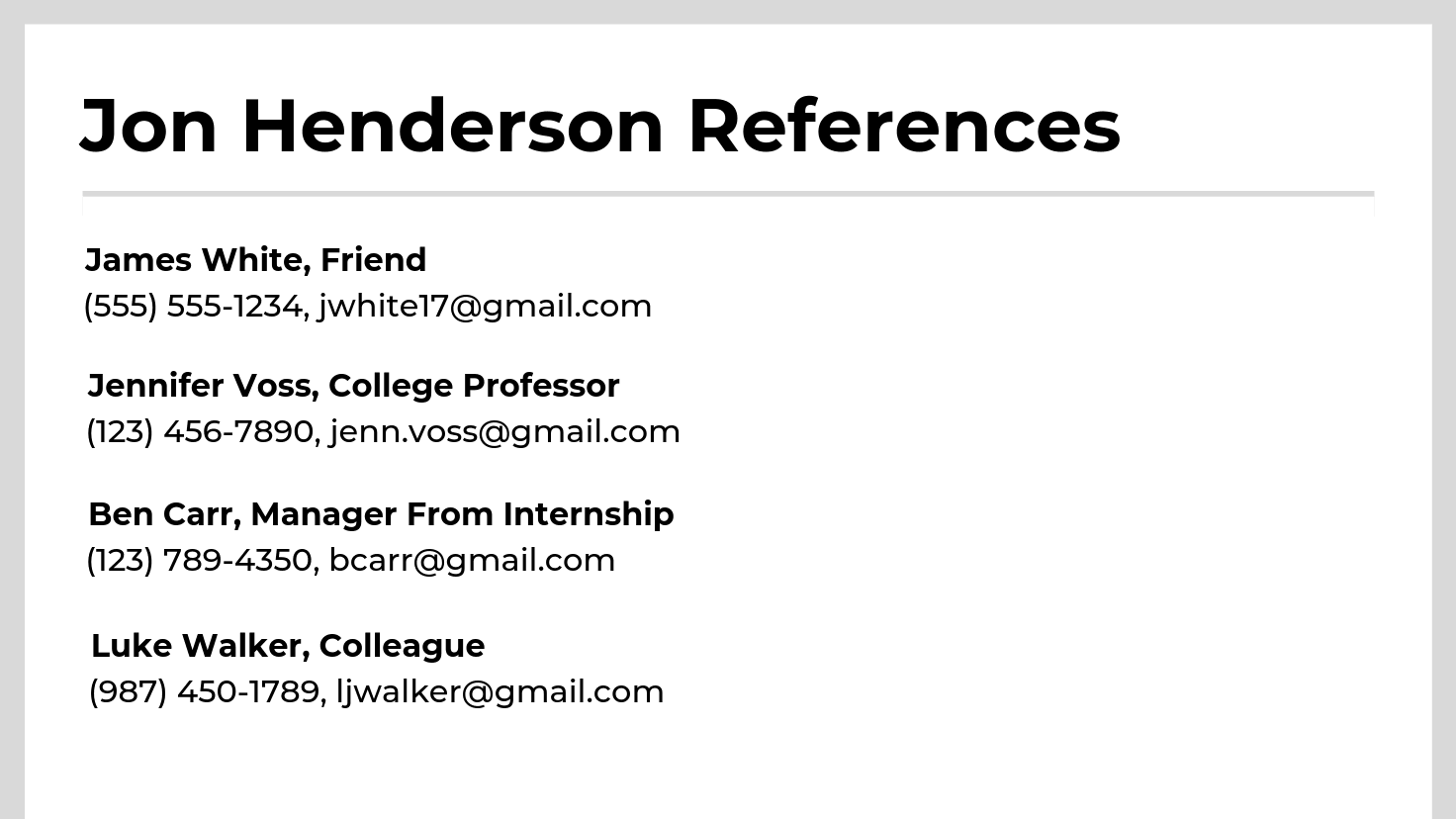
This one looks better, but we've still got some issues.
First, the prioritization is all wacky. This person is leading off with a friend while their current colleague is buried down at the bottom. That's not a great look.
What if they only decide to contact the top three references? They'd get a friend, a teacher, and someone who managed this person when they were an intern. That's not gonna work.
Next, there's little to no context here. What company is Luke Walker a colleague at? Is it a current company? A former company?
What projects did you work on with these people or how did they impact you?
There's nothing to clarify why this person listed them, which leaves the whole conversation up to the person making the call. That can lead to a seriously awkward conversation or, at best, one where they really need to dig to get the info they want.
Your goal is to make it easy for the person calling!
Example #3:
A Great Example Of How You Should List Your References (Definitely Do This!)
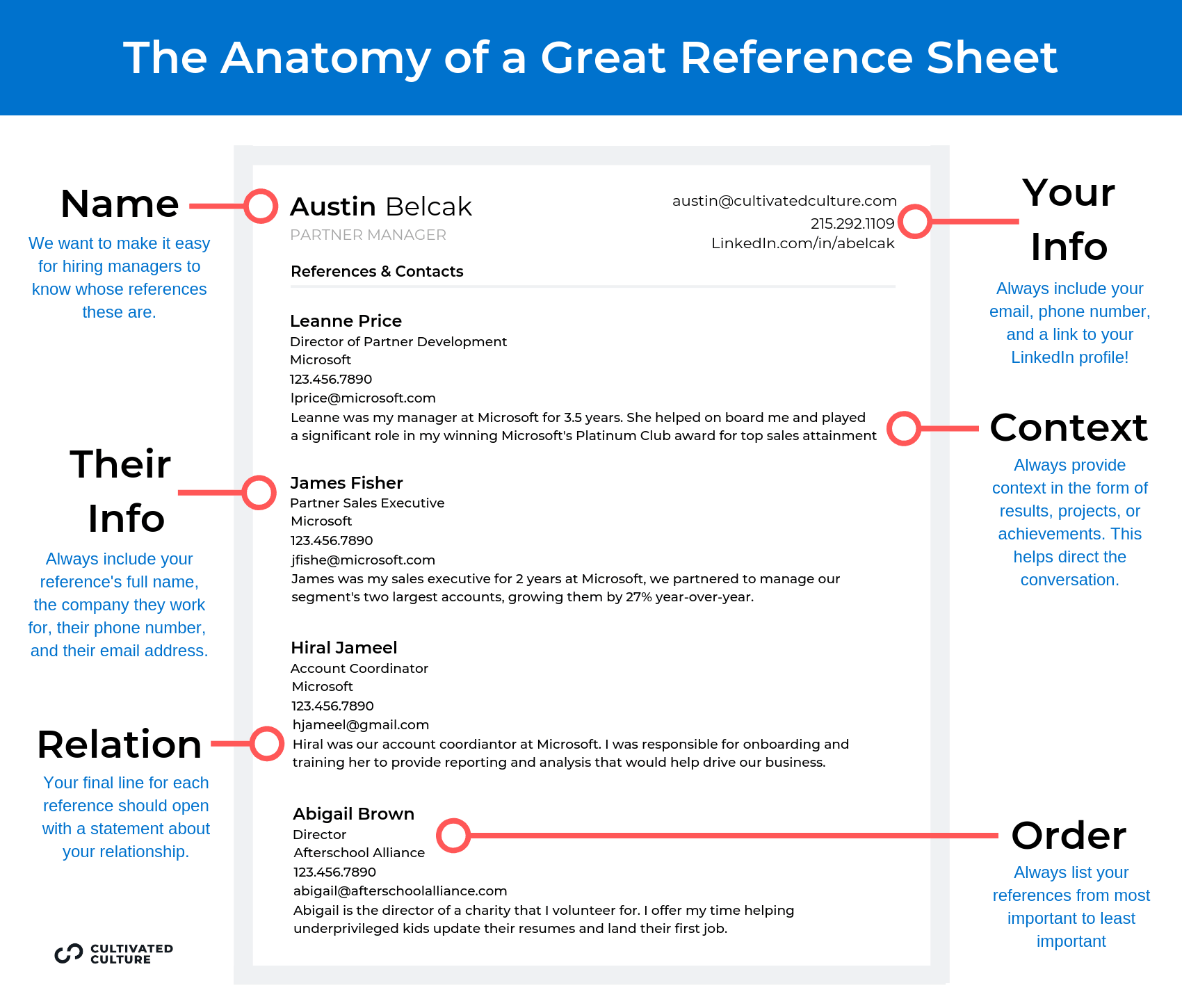
Boom! Look how awesome that is.
We've got our full name and all of our contact info right at the top. The reader immediately knows who we are, they can look us up if they need to, and our email/phone is available for any questions or feedback.
Our references are all broken out in a clear and clean fashion. Each person's title, company, and contact info are readily available and we've taken the opportunity to “drive” the conversation here with a few lines of context at the bottom. Note that we defined the relationship at the beginning of that context.
If you're not differentiating yourself at every step of the job search process, you're getting lost in a sea of applicants. Plus, all this extra detail will help you (and your references) build a rapport with your employer.
The example above shows the exact level of detail you need to add to your resume references list. If you use that as a guide and format your own reference sheet in a similar fashion, you'll be ready to go!
All you need to do now is find your people, shoot them a note asking if they'll vouch for you, and get your references sheet set up. You'll want to have it ready to go at that next interview!
Salary Negotiation: Preparing For The Final Offer
What's the last step in the interview process? The final offer letter. If you've made it this far, congratulations! You'll want to be prepared ahead of time by checking out my article on how to negotiate your salary during an interview.
I'll show you 3 simple negotiation tips that you can use to double your offer! While finding the courage to speak up about your salary and negotiating what you’re worth can be tough, it’s an absolute must. If you’re not negotiating your salary properly, you’re leaving tons of money on the table. Don't miss out on the opportunity to get paid what you're really worth!








